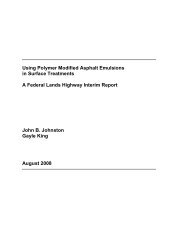Spray Applied Polymer Surface Seals - TSP2
Spray Applied Polymer Surface Seals - TSP2
Spray Applied Polymer Surface Seals - TSP2
Create successful ePaper yourself
Turn your PDF publications into a flip-book with our unique Google optimized e-Paper software.
Lessons Learned<br />
How to Apply <strong>Seals</strong><br />
Very low binder application<br />
• Diluted for better control<br />
Avoid contamination<br />
• Dilution at manufacturer’s plant<br />
Reduces contamination possibility<br />
Increases transportation costs<br />
Climatic conditions<br />
• Temperature & humidity to allow reasonably fast cure<br />
Sanding<br />
• Fractured, dry sand<br />
• After curing for rejuvenators; before curing for asphalt seals<br />
• Broom if adverse effect on friction, on city streets<br />
Dilution<br />
While at least one agency strongly recommends dilution of the emulsions at the manufacturer’s<br />
location to avoid over- or under-dilution and introduction of impurities than can break the emulsion or<br />
otherwise harm the performance, some manufacturers believe that transportation and mobilization<br />
costs can be saved by diluting on-site—with careful control of the dilution method, rate and<br />
water/solution.<br />
Climatic Conditions<br />
Because of knowledge of the success of local projects, agency and supplier recommendations for<br />
surface and air temperature should be strictly followed. At least one project was delayed to avoid<br />
run-off of uncured materials by an imminent rain.<br />
Sanding<br />
Sanding on the 2006 projects showed an immediate increase in friction. (The manufacturers of some<br />
of the rejuvenator products recommend sanding because of an oily coating on aggregate surfaces.<br />
In this study, the rejuvenators did best when sanded after they were allowed to infiltrate the surface.<br />
The stiffer asphalt emulsions did better when the sand was applied before the emulsion was fully<br />
broken. Some of the manufacturers say that sanding is not needed, and that was the case in this<br />
study, especially on the chip seals and more open surfaces. The application rate and type of sand<br />
are also factors to be considered. When sand is applied, it is recommended that a high quality,<br />
crushed sand with adequate fine aggregate angularity (FAA) be used to give the desired friction<br />
numbers. The sand should also be sufficiently small to prevent damage to windshields and relatively<br />
dry to avoid slowing cure. For specifications, a saturated surface dry condition is probably the<br />
maximum amount of moisture that should be allowed.<br />
Loose sand can itself cause a loss in friction, so it should be broomed. Sand also creates clean-up<br />
problems for curb-and-gutter or other urban applications where surface water drains might be<br />
plugged. Hence, some agencies prefer sand be avoided. Sanding is not necessary for some<br />
products. The supplier's recommendations should be followed.<br />
64
















